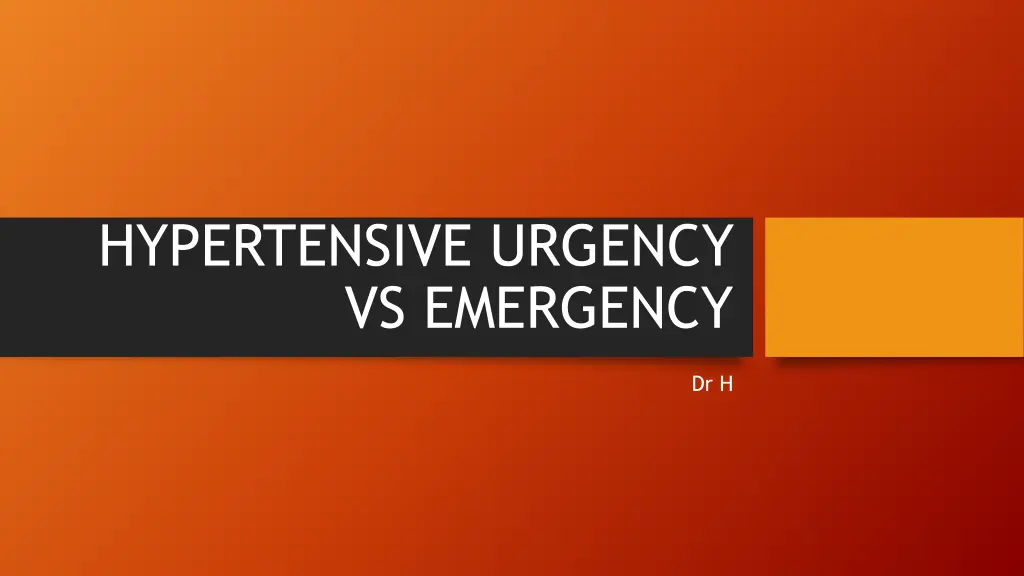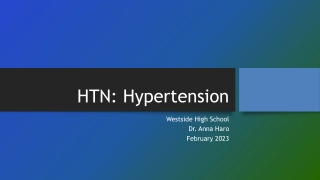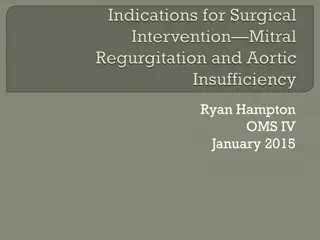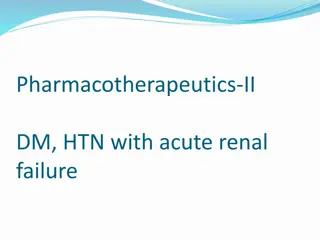
Hypertensive Urgency and Emergency Management Guidelines
Learn about the differences between hypertensive urgency and emergency, including treatment approaches for each condition. Discover how to manage elevated blood pressure levels effectively to prevent organ damage and complications. Understand the importance of gradual blood pressure reduction to avoid potential ischemic damage. Explore specific treatment strategies for hypertensive emergencies like acute organ dysfunction, aortic dissection, acute stroke, acute hemorrhagic stroke, hypertensive encephalopathy, and post-operative hypertension.
Uploaded on | 0 Views
Download Presentation

Please find below an Image/Link to download the presentation.
The content on the website is provided AS IS for your information and personal use only. It may not be sold, licensed, or shared on other websites without obtaining consent from the author. If you encounter any issues during the download, it is possible that the publisher has removed the file from their server.
You are allowed to download the files provided on this website for personal or commercial use, subject to the condition that they are used lawfully. All files are the property of their respective owners.
The content on the website is provided AS IS for your information and personal use only. It may not be sold, licensed, or shared on other websites without obtaining consent from the author.
E N D
Presentation Transcript
HYPERTENSIVE URGENCY VS EMERGENCY Dr H
HYPERTENSIVE URGENCY Elevated blood pressure without end-organ damage Oral medication to bring down BP over 24-48 hours Start with up-titrating home regimen (or giving missed dose) These patients can be discharged
WHY NOT TREAT EVERYONE QUICKLY? Vasculature has become used to the high pressures Dropping blood pressure too fast can lead to ischemic damage
HYPERTENSIVE EMERGENCY Hypertension associated with acute organ dysfunction Organ Dysfunction MI, Aortic Dissection, LV Failure with Pulmonary Edema, Encephalopathy, Hemorrhagic Stroke, Microangiopathic Hemolytic Anemia, Pregnancy, Acute Post-Operative, Kidney Injury In general, decrease MAP by 10-20 % in the first hour and then another 5-15% in the next 23 hours
AORTIC DISSECTION SBP <120 (or normalization) within 20 minutes. Esmolol preferred agent Must beta block before initiation of vasodilators Other options include nicardipine and nitroprusside as well as labetalol
ACUTE STROKE Goal SBP <220 within 1 hour Preferred agent nicardipine Other agents include medications like labetalol If patient a tPA candidate, SBP must be <185
ACUTE HEMORRHAGIC STROKE Goal SBP <140 within 1 hour Preferred agent nicardipine Other agents include medications like labetalol Goal is to decrease hematoma growth
HYPERTNESIVE ENCEPHALOPATHY Lower MAP 20-25% within 1 hour Preferred agent labetalol Other agents include nicardipine and nitroprusside
POST-OPERATIVE HYPERTENSION Goal SBP <180 within 1 hour Nicardipine and labetalol preferred agents Treat reversible factors
ACUTE CORONARY SYNDROME In general, decrease MAP by 10-20 % in the first hour and then another 5-15% in the next 23 hours Common agents include nitroglycerin, nicardipine, metoprolol and esmolol, but all depending on the type of acute coronary syndrome and location of infarct.
ACUTE LV FAILURE WITH PULMONARY EDEMA Decrease MAP by 10-15% in the first hour and then achieve normal BP within 23-48 hours (unless still symptomatic) Administer bolus of loop diuretic and start titratable vasodilator (nitroglycerin or nitroprusside) Avoid hydralazine and beta blockers initially
RENAL EMERGENCIES Hematuria plus Elevated Creatinine This is usually from prolonged HTN and acutely lowering BP can cause worsening of the renal function.
PEARLS Hypertension can cause a multitude of medical problems. True emergencies require finesse to stop the end-organ damage but not induce ischemic damage. The most important aspect of care is close outpatient follow-up to ensure blood pressure is controlled over time.




